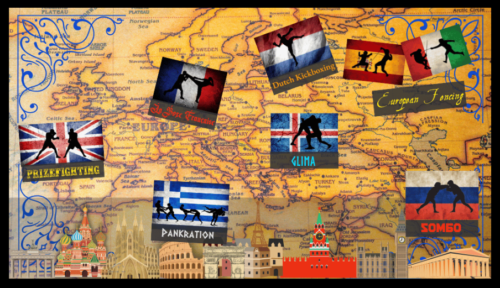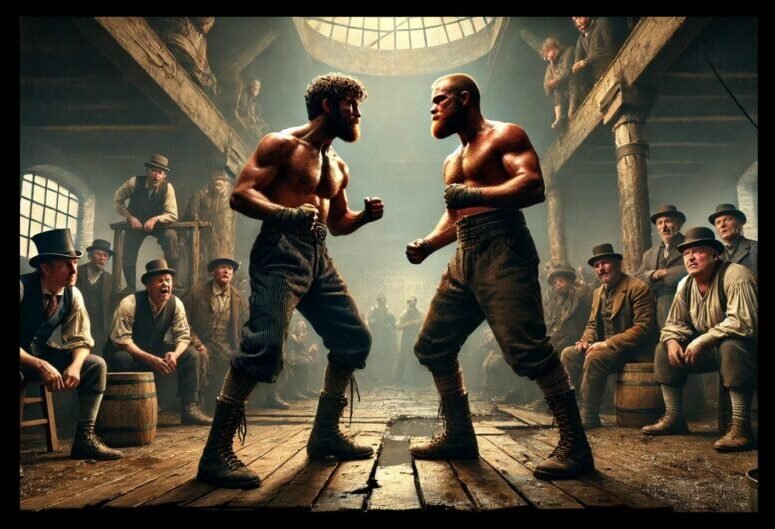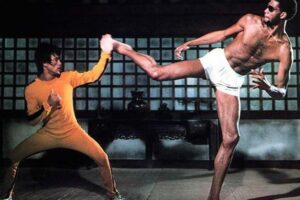From Egyptian murals to Roman bloodsport, from British pits to Las Vegas lights—boxing has always been more than fists. This post takes you through its ancient origins, brutal revivals, golden eras, scandals, and global icons. It’s the full story of the prizefighter—how a brawl became a billion-dollar empire, and why the fight never dies.
Table of Contents
Before the Bell 🔔
Back Alleys, Barrooms, and Broken Noses
Before the flashing lights, title belts, and million-dollar paydays, boxing was little more than bone-crunching scraps fought in back alleys, barrooms, and hay-covered pits. There were no gloves, no rounds, and no referees—just two men trading pain until one couldn’t stand. This was the brutal world of the prizefighter—a world that laid the foundation for modern-day boxing as we know it.
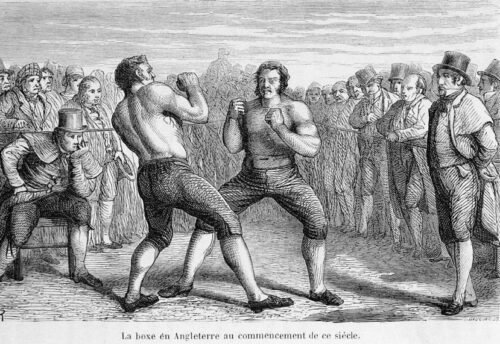
Long before modern rules, early prizefights were fought bare-knuckle, often in fields or taverns. They drew huge crowds in the 18th and 19th centuries when boxing was still an outlaw sport.
In this post, we chart the rise of Western boxing — from its ancient origins and brutal early days to the rise of rules, regulation, and global superstardom. It’s the story of how prizefighting evolved from back-alley brawls into one of the world’s most respected and influential combat sports.
Whether you’re a fan of the old-school brawlers or the slick technicians of today, this is the story of how fists forged an empire—and how boxing became the ultimate test of courage, strategy, and survival.
🏛️👊🏼 Ancient & Early Boxing
Boxing is as old as civilisation itself. From ritual duels in Egypt to Olympic contests in Greece and gladiatorial brawls in Rome, the fist was always a weapon of honour and survival. When empires fell, the sport faded, but the instinct never vanished—kept alive in folk traditions across Europe, Africa, Asia, and the Americas until its modern rebirth.
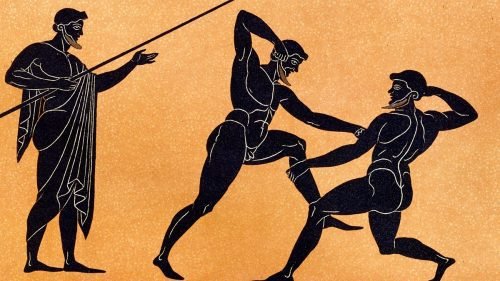
In Greece, boxing (pygmachia) was a brutal Olympic contest fought bare-fisted with leather thongs, while in Rome it lost its sporting honour, with gladiators wearing metal-studded cestus and often fighting to the death.
Click on the links below for more
✊🏽 Pugilism in the Age of Antiquity
Long before the gloved prizefighters of today, early forms of boxing were already taking shape across ancient civilisations. Murals in Egypt depict bare-fisted contests dating back to 3000 BC. The Greeks refined this into pygmachia—a brutal Olympic event where combatants fought with leather-wrapped fists and no rounds or weight classes. Rome inherited the sport, but stripped it of honour; matches often devolved into gladiatorial bloodbaths, with fighters wearing metal-studded gloves called cestus. As the Roman Empire fell, so too did the sport—buried under centuries of decline and disuse.
⚔️ Western Traditions Through the Centuries
When Rome fell, formal boxing vanished, but the fist fight never did. Through the Middle Ages, scraps raged in taverns, fairs, and army camps—more brawl than sport, but still a test of toughness. In 17th-century Ireland, clan faction fights mixed sticks and bare fists in brutal spectacles that foreshadowed the Irish prizefighters to come. The Renaissance kept striking alive in subtler ways, with Italian fight books like Fiore dei Liberi’s showing punches alongside wrestling. Even in Persian koshti or Turkish yağlı güreş, the fist crept into grappling traditions.
By the 16th and 17th centuries, England stirred again. Pugilism re-emerged, Shakespeare used “box” for a punch, and reports told of rough prizefights mixing throws with strikes.
It wasn’t yet the structured sport Britain would forge in the 18th century, but the ground was already being laid. The prizefighter’s return was inevitable—London’s pits were waiting.
🌍 Fists Across the World
Though Europe largely forgot fist fighting after Rome, it surfaced in many guises: West Africa’s Hausa practiced Dambe, with one bound fist as the “spear” and the other guarded; India’s musti-yuddha, blending punches with grappling and kicks; China’s lei tai contests, where striking mixed with martial tests; and Japan’s kakedameshi fist brawls among samurai and commoners. Even the Americas had echoes of pugilism, with Spanish chroniclers noting Aztec and Inca duels fought bare-fisted.
These were not codified sports but folk contests, ritual duels, and martial training. Yet they show that while Europe waited for the prizefighter’s return, the fist as a weapon of honour, survival, and spectacle never disappeared.
But it was not until the 1700s that a small island nation finally dragged the fistfight out of the fairground and into the ring, setting the stage for modern boxing.
🥊📜 The Founders of the Modern Fight Game
By the 18th century, the prizefight re-emerged in a new form. Rough tavern scraps and gambling spectacles in Britain slowly evolved into a sport with rules, champions, and audiences that stretched far beyond the pit. Prizefighting was about to undergo a transformation—one defined by structure, reform, and a growing sense of legitimacy. Its influence would soon spread across the world, reshaping the art forever.
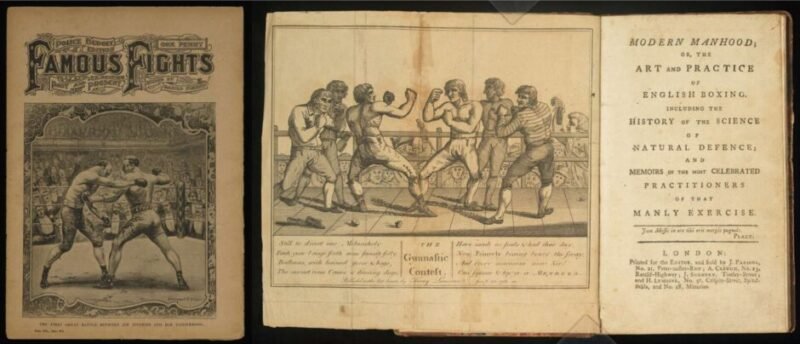
Promoters and publishers drove boxing forward in the 18th century, from penny prints to Victorian manuals.
🇬🇧 Britain – The Skeleton of the Sport
Boxing’s rebirth came in 18th-century England, where bare-knuckle prizefighting grew from tavern brawls into a regulated spectacle. Crowds would pack fields and fairgrounds to watch champions like James Figg and Jack Broughton trade blows for money and honour. Broughton introduced the first rules in 1743, banning certain fouls and standardising the ring. Later came the London Prize Ring Rules and eventually the Queensberry Rules, which introduced gloves, timed rounds, and weight divisions. Britain gave the fight game its skeleton—codifying technique and discipline, and turning what was once a brawl into something society could finally embrace.
👉 Explore the full story: The British Influence on Boxing
🇺🇸 🗽 American Boxing Legacy – Turning Blood into Business
Picking up the baton from their transatlantic cousins, the US took boxing’s framework and turned it into a spectacle of scale. In the 19th century, immigrant fighters—Irish, Italian, Jewish—battled for survival and pride in the gyms of New York, Philly, and Chicago. By the early 20th century, promoters like Tex Rickard were filling Madison Square Garden with huge crowds, and Jack Dempsey’s million-dollar gates proved boxing could outdraw any sport in America. Hollywood, newspapers, and later television amplified the drama. America injected flesh and fire into boxing—commercialising it, glamorising it, and building a stage where prizefighters became national heroes.
👉 Explore the full story: The American Influence on Boxing
🌍 International Boxing – The World Takes Notice
By the 20th century, Britain’s colonial reach, US military presence, and global media carried boxing far beyond its Anglo-American roots. Cuba became a hotbed of technical brilliance; Mexico produced relentless pressure fighters; Japan refined precision and discipline; the Philippines embraced wild, unorthodox aggression. Each culture moulded the sport into its own reflection, from Soviet amateur machines to African heavyweights like Joshua and Usyk emerging later. The ring had become a global language of ambition, pride, and struggle—spoken differently in every nation, but understood everywhere.
👉 Explore the full story: The International Impact of Boxing
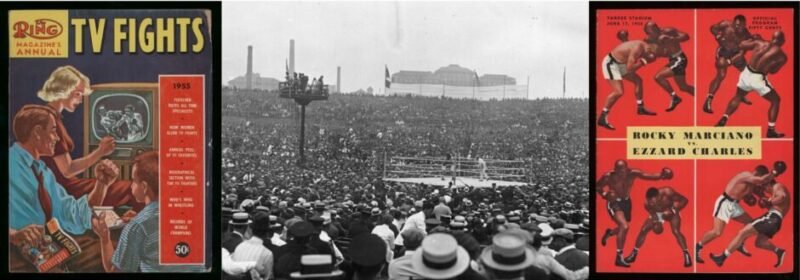
By the 20th century, boxing was no longer a backstreet gamble—it was stadiums, superstars, and families gathered round the television to watch the fight game unfold.
What followed was boxing’s Golden Era — when the prizefighter became not only a champion in the ring but also a cultural icon, a political symbol, and, in some cases, a global hero.
🕰️ The Golden Eras – Boxing’s 20th Century Boom
By the mid-20th century, with wars, migration, and television carrying fighters across borders, boxing was no longer just a British-American story. The prizefighter had stepped out of the fields, into the stadiums, and onto the world stage—ushering in boxing’s Golden Eras of the 20th century.
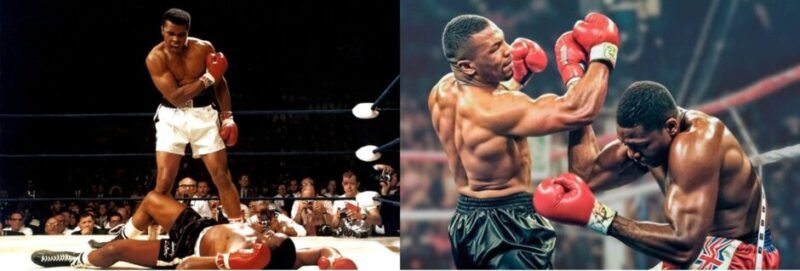
The Golden Era was boxing at its cultural peak—stadiums full, politics in play, and champions as household names. Ali and Tyson, in their very different ways, embodied everything that age came to mean.
Click on the links below for more
🥊🌍 The People’s Champion – Joe Louis and Post-War Boxing
In the 1930s and 40s, Joe Louis became more than a heavyweight—he was a national symbol. His rematch victory over Max Schmeling in 1938 wasn’t just a fight — it was a punch landed on Nazi propaganda. After World War II, boxing filled a cultural void. Television beamed Friday Night Fights into living rooms, turning men like Rocky Marciano, Sugar Ray Robinson, and Floyd Patterson into household names. Boxing became part of the new global identity — accessible, dramatic, and unifying.
🥶 Boxing and the Cold War
Boxing has always been a political stage. In the Cold War, amateur boxing became another front line—Cuban and Soviet fighters squaring off against Americans in Olympic rings while governments tallied medals like battlefield victories. Teófilo Stevenson became a Cuban hero not just for his fists but for rejecting million-dollar offers to turn pro, declaring, “What is one million dollars compared to the love of eight million Cubans?” During those years, every Olympic bout carried more than medals — it carried messages, and the prizefighter bore the weight of national pride.
🗣️👑 Ali’s Era – Politics, Personality, and the Heavyweight Crown
The 1960s and 70s produced the most iconic heavyweight scene in history. Muhammad Ali’s charisma and defiance clashed with Joe Frazier’s grit and George Foreman’s power in battles that transcended sport. The Rumble in the Jungle (1974) and Thrilla in Manila (1975) became cultural landmarks, not just contests. Ali made boxing theatre, philosophy, and resistance rolled into one—proof that a fighter could change the world with words as much as punches. The prizefighter had become more than a brawler—he was a global voice.
🌍 The Olympic Forge
While professional boxing built its legends in stadiums, the amateur game built its future in gyms and Olympic arenas. The Games turned unknowns into household names—Cassius Clay in Rome ’60, George Foreman in Mexico ’68, Teófilo Stevenson dominating for Cuba in the 70s, Lomachenko and Usyk representing Ukraine decades later. In nations where pro boxing was restricted or banned, the amateur path was the only one available. Without this global pipeline, the professional ring would have lacked many of its greatest champions.
⚡🔥 The Fabulous Four – Skill, Speed, and Fire in the Middle Divisions
If the heavyweights ruled headlines, the 1980s belonged to the middleweights. Sugar Ray Leonard, Roberto Durán, Marvin Hagler, and Thomas “Hitman” Hearns—the “Fabulous Four”—produced some of the greatest fights ever recorded. Each brought a distinct style: Leonard’s flash, Durán’s ferocity, Hagler’s granite will, and Hearns’ lethal right hand. Their clashes proved boxing was as much about artistry as power, and that the lower divisions could deliver just as much spectacle as the giants. They showed how the prizefighter’s spirit thrived outside the heavyweight division.
🐯⚡ Iron Mike and the 90s – Power, Fame, and Chaos
The late 80s and 90s gave the world “Iron” Mike Tyson—boxing’s youngest heavyweight champion and perhaps its most fearsome. Tyson’s aura of invincibility turned his fights into global events, even when they lasted less than a round. He was the prizefighter distilled to his most primal form: fear, power, and spectacle. Yet his fall from grace, alongside rivalries with Evander Holyfield and Lennox Lewis, showed how quickly boxing’s fortunes could turn.
Lewis, the cerebral powerhouse from Britain, unified the heavyweight crown and restored order back to a chaotic division. The decade also gave rise to technical brilliance in other divisions—Oscar De La Hoya, Roy Jones Jr., and Pernell Whitaker ensured the spotlight wasn’t just on the big men.
⏳🥊 Boxing at the Century’s Close
By the year 2000, the sport had reached a paradox. Boxing remained massive—filling stadiums and breaking pay-per-view records—but faced rising competition from mixed martial arts and its own fractured governance. Yet the echoes of the Golden Eras still shape how boxing is remembered: the courage of Louis, the wit of Ali, the wars of the Four Kings, and the storm of Tyson.
The 20th century built boxing’s legends; the 21st would test its survival. The new millennium would bring more money than ever—and more fractures, controversies, and questions about where the sport was headed.
🥊 The Modern Era – Superfights, Scandals, and Survival
As the new millennium dawned, the prizefighter wasn’t fading—he was adapting. Boxing entered the modern era as both a billion-dollar business and a cultural battleground, with new icons rising and old problems refusing to die.
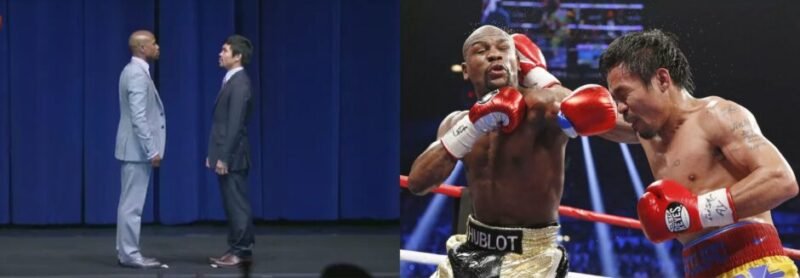
The richest fight in boxing history—Mayweather vs Pacquiao, the modern prizefight as billion-dollar business.
Click on the links below for more
💰👑 Pay-Per-View Kings and Fractured Titles
The 2000s cemented boxing as a global money machine. Floyd Mayweather, Manny Pacquiao, and Oscar De La Hoya became household names, but the era also highlighted the sport’s flaws. With rival promoters and sanctioning bodies—WBA, WBC, IBF, WBO—titles multiplied with each body declaring its own ‘world champion,’ leaving fans with an alphabet soup that diluted the crown. Superfights stalled, and fans grew frustrated with politics outside the ring.
💼 The Business of Boxing
Behind every champion stood the real heavyweights—the promoters. Don King, Bob Arum, Eddie Hearn—they weren’t just making matches, they were shaping the game’s future. They turned grudges into goldmines, but also split the sport into warring kingdoms. They controlled television contracts, sanctioning bodies, and match-ups, often keeping the biggest fights hostage until the payday was right. Promoters turned boxing into a profit-making industry, but also fractured it into rival camps, sanctioning bodies, and endless “champions.” For the fighter, this meant paydays grew—but so did the politics.
🥊💵 The Mayweather–Pacquiao Era
The richest fight in boxing history finally arrived in 2015, years after anticipation peaked. Yet for all the business politics, it was still prizefighting at its core: two men chasing the biggest purse of their lives. Mayweather’s precision and Pacquiao’s aggression drew global attention, but the late timing left some fans disillusioned. Meanwhile, the heavyweight spotlight dimmed in the US, dominated instead by the efficient but less marketable Klitschko brothers across Europe.
🌟🔥 New Icons Rise
As old stars faded, new ones carried the torch. Canelo Álvarez embodied Mexico’s fighting pride, combining commercial power with technical craft. In Britain, Anthony Joshua and Tyson Fury revived heavyweight glamour, later joined by Oleksandr Usyk, whose finesse reminded fans of boxing’s tactical roots.
👩🦰🥇 The Breakthrough of Women’s Boxing
Trailblazers like Christy Martin and Laila Ali proved women could headline even when the sport barely acknowledged them. The 2010s marked a turning point for female fighters. Katie Taylor, Claressa Shields, and Amanda Serrano headlined major events, selling out arenas and proving that women’s boxing could command respect and global audiences.
📺⚔️ Boxing’s Survival in the MMA Era
With MMA and the UFC surging in popularity, boxing had to adapt. Streaming platforms brought global access, while crossovers like Mayweather–McGregor (2017) and Fury–Ngannou (2023) kept it in the headlines. New talent continued to emerge from every corner of the world. Controversy and corruption persisted—but so did the crowds. The prizefighter’s world endured, proof that no matter the competition, boxing’s legacy remains unshakable.
Still, beneath the billion-dollar gates and glittering lights, old problems refused to die. Boxing’s greatest opponent has never been the UFC—it has been its own corruption.
🌑 The Dark Side of the Fight Game
Boxing has always walked a fine line between glory and ruin. The same drama that fills arenas has long been shadowed by controversy and cost. For every sold-out stadium and championship belt, there’s a trail of broken bodies and broken trust.

Behind the glory lies risk. From Michael Watson’s collapse to Gerald McClellan’s life-altering injuries and Maxim Dadashev’s fatal bout, boxing’s history shows why medical safeguards are as vital as the fighters themselves.
Click on the links below for more
⚖️ Controversy and Corruption
If the violence is boxing’s selling point, corruption has long been its shadow. From questionable judging in Olympic bouts—like Roy Jones Jr. being robbed of gold in Seoul ’88—to championship fights decided by politics instead of punches, the sport’s integrity has often been stretched thin. Promoters, sanctioning bodies, and judges have too often shaped outcomes to serve business, not boxing. Mismatched fights, shady fees, and delayed superfights eroded fan confidence and even drove some toward alternatives like MMA. Yet paradoxically, scandal keeps the sport alive. Controversy doesn’t kill boxing—it fuels it. It feeds the debates, grudges, and storylines that audiences still pay to see settled in the ring.
🩸🧠🦴 The Price of the Prizefighter
Beyond politics lies the human toll. Boxing’s cost is steep: shattered hands, detached retinas, ruined joints, chronic brain injury—and, too often, death in the ring. The price is nothing new; fighters have paid it since the days of the cestus and the bare-knuckle pits. Only the scale of the spotlight has changed.
Stories like Jerry Quarry’s decline or Muhammad Ali’s long battle with Parkinson’s reveal how high that cost can climb. For every champion immortalised in highlight reels, dozens fade into silence—carrying the scars of a sport that gave them everything and nothing.
Boxing’s great paradox is this: the same violence that builds its heroes is what breaks them.
And still, men climb through the ropes—chasing glory, redemption, or simply the need to prove they exist.
🏙️ Boxing Hubs Today
Where the Fight Lives Now
The prizefighter may be global, but its heartbeat still pounds loudest in certain cities. From glittering arenas to basement gyms, these hubs remain the proving grounds where reputations are built and boxing culture refuses to die.
Global Boxing Capitals
🇺🇸 United States – Las Vegas, New York, Philadelphia, Detroit, Los Angeles, Houston.
🇲🇽 Mexico – Mexico City, Guadalajara, Tijuana.
🇬🇧 United Kingdom – London, Manchester, Liverpool, Sheffield, Birmingham.
🇯🇵 Japan – Tokyo, Osaka.
🇨🇺 Cuba – Havana, Santiago de Cuba.
🇺🇦 Ukraine – Kyiv, Odessa, Lviv.
🇵🇭 Philippines – Manila, Cebu, General Santos City.
🇰🇿 Kazakhstan – Almaty, Astana.
🇹🇭 Thailand – Bangkok, Nakhon Ratchasima.
🇨🇦 Canada – Montreal, Toronto.
🇦🇺 Australia – Sydney, Melbourne.
🇿🇦 South Africa – Johannesburg, Cape Town.
These cities are more than fight capitals — they’re where the sport still breathes through sweat, pride, and tradition.
🔮 The Future of the Prizefighter
If the 20th century was about globalisation and the 21st about survival, then the future of boxing sits at a crossroads. The prizefighter is still here, but the world around him has changed.

The future of boxing lies in contrasts: blockbuster spectacles like Mayweather–McGregor show the sport’s pull as global entertainment, while humble gyms in Africa and beyond remind us that the next great champion is more likely forged in struggle than in lights.
Click on the links below for more
🎪 Crossover Spectacle
YouTube personalities and influencers like Jake Paul and KSI have dragged millions of new eyes back to the ring — for better or worse. They understand hype, algorithms, and audience psychology better than most promoters. Their fights target Gen Z and casual fans rather than purists. Production is slick, trash talk relentless, and the events are easily streamed worldwide. Purists call it a circus, but the numbers don’t lie. These events may not build legacies, but they keep boxing in the cultural bloodstream. Bottom line: people pay to watch, even if it’s a circus. That revenue keeps the model alive.
👊🩸 Bare-Knuckle Revival
Once outlawed, bare-knuckle fighting has resurfaced with a vengeance. These promotions succeed because they offer something fans feel boxing and MMA have lost—raw violence, fast knockouts, and minimal rules. The format guarantees action, the fights are short and brutal, and the marketing leans into danger and authenticity. Events promoted by stars like Conor McGregor have blurred the line between spectacle and savagery, echoing the pits of the 18th century while streaming to millions worldwide. It’s cheap to run, appeals to bloodsport fans, and delivers the kind of chaos that goes viral.
👩🦰🥊 Women in Boxing
Women’s boxing has broken through in recent years, with fighters like Katie Taylor and Claressa Shields proving they can headline major cards. The sport now has real female stars and a dedicated following. Still, parity with the men’s game remains unlikely. Boxing is driven by ticket sales, viewership, and global demand, and at the very top level those numbers remain heavily skewed toward men’s fights. Women’s bouts can and do draw, but they operate on a different scale. The growth is real, but the market realities set the ceiling.
🌍🥊 Global Growth
The next Ali or Tyson may not come from New York or London but from Lagos, Almaty, or Bangkok. With gyms sprouting in every corner of the globe, the sport’s future stars are as likely to be shaped by poverty in Africa or discipline in Asia as by American promoters. Nations once peripheral to the fight game are now producing world champions, and regional styles are evolving just as Britain and America once did. Boxing’s new bloodlines are global, and its future may well belong to the hungry, not the established.
🤖📊 Technology & Training
Streaming platforms, AI-driven analytics, and new training sciences are changing how fighters prepare, how fans watch, and how careers are built. Today’s boxers track punch volume, heart-rate zones, and sparring efficiency with data once reserved for elite labs. Virtual sparring partners and real-time feedback are reshaping gyms, while fans consume fights on phones instead of pay-per-view TV. Boxing is both more accessible and more fragmented than ever — a sport straddling tradition and innovation, old-school grit and next-gen science.
The prizefighter’s future may not look like its past. It might be fought in four-ounce gloves under neon lights, hyped by YouTubers, or streamed to phones rather than shown on primetime TV. But the essence won’t change. Somewhere, someone will always want to prove themselves with their fists.
🏁 Conclusion – The Echoes of the Prizefighter
From the blood-soaked sands of the Colosseum to the neon glare of Las Vegas, the cost of boxing has always been the same. Only the stage has changed. It began as raw instinct—brutal and unrefined—before being sculpted by British structure and ignited by American showmanship. Across centuries, it transformed from lawless brawls into a sport governed by honour, strategy, and survival.
Yet boxing’s true power lies in its adaptability. Each culture that embraced it made it their own—Mexico’s iron-willed pressure, Japan’s surgical precision, Ukraine’s tactical mastery, Cuba’s technical flair, and the Philippines’ chaotic grit. The ring became a global stage, but the fight remained deeply personal: one-on-one, everything to prove.
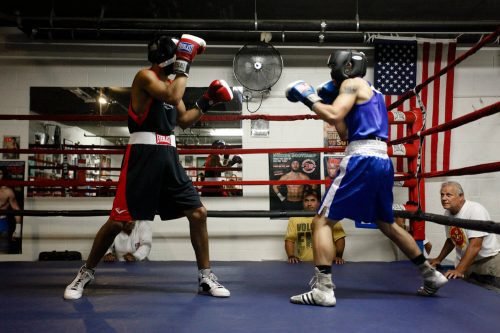
The prizefighter’s story always begins the same: in the gym, trading blows, paying in blood, sweat, and tears—long before fame or fortune arrives.
Today, champions rise from every postcode and every continent. The language may vary, but the rhythm of footwork, feints, and fury remains universal. Somewhere right now—in a cracked-mirror gym, a favela, a subway basement—a young fighter is shadowboxing his demons, dreaming of legacy. Just like they did 200 years ago.
Modern boxing may be wrapped in pay-per-view lights and million-dollar contracts, but beneath the glamour, it still bleeds the same blood. The prizefighter lives on—not just in highlight reels or history books, but in every jab thrown, every chin tested, every bell rung. From a kid shadowboxing in Havana to a millionaire walking into Vegas, they’re still chasing the same thing: a purse, a legacy, a fight. The fight game endures.
If you have enjoyed this post please share or feel free to comment below 🙂
Related Posts
Our Other Posts

